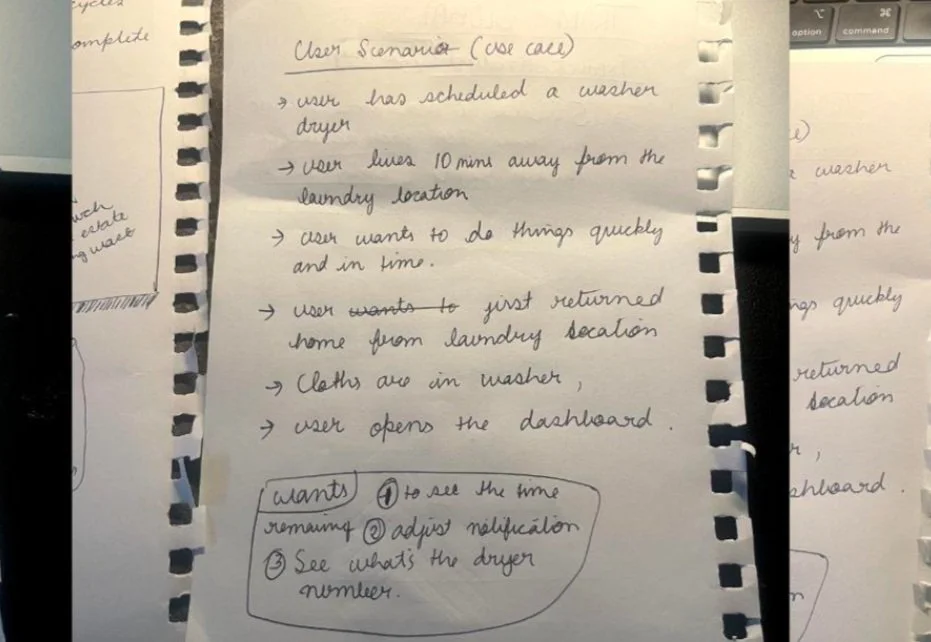Eco-Laundry — Smart Service Management
This project showcases my end-to-end process for feature design, focusing on a streamlined Laundry Management System (LMS) tailored to optimize laundry operations. By identifying user pain points and enhancing the overall experience, the goal was to deliver an intuitive, scalable solution that simplifies workflows and drives operational efficiency.
Eco-Laundry — Laundry Management Software
Product Design, 2023
The Process1/7 Understanding the Brief
First, I analyzed the use case to grasp the project objectives and key aspects.
The time invested in reflecting on this brief is directly proportional to the number of open-ended questions it raises in my mind.
I understood that this application will revolve around the life of a laundry employer and needs to help him make decisions.
1. How does the employer function?
2. What does his daily routine in the shop look like?
3. How many orders does a single employer take care of?
4. What’s the flow from order received till order delivered?
Okay, we’re talking about a LMS (laundry Management Software) here but,
1. What’s the top priority information the employer wants to see first, second, and third?
2. Should he see the order ID first because he’s handling different orders and would at any given point want to check on a particular order?
3. What filters will help him come to decisions quickly?
2/7 Qualitative research
After reviewing the brief, I decided to speak with someone whose routine closely resembled that of the target user. I reached out to a friend who fits this profile and uses a laundry service at least once a week.
Interview Participant & her flow of actions.
Name : Diksha Rawat
Profession: Student
Routine: Takes out laundry for herself and her roommate atleast once a week.
Where: Nearby laundry service.
Painpoints in her Journey
While conversing with the interview participant, I paid attention to her tone and emotion when she mentioned a few things like,
Two major pain points from the interview participant validate the challenges mentioned in the brief.
1. The user faces a problem with machine numbers.
2. The user loses track of the remaining time.
3/7 Comparative Analysis
Now I have some clarity as to what needs to be designed but before that I need to research on some existing platforms.
I use ShinePay personally, installed a couple of applications like Laundryheap, and PayRange, and went through some websites to understand the process. But I didn't find any trusted LMS or maybe I needed some kind of access to them.
I still had some open-ended questions that would haunt me later when I design the application blueprint - so I started need finding research more extensively.
I started going through Laundry Application case studies on the net, any related articles that could clear a few doubts, searches after search, one link leads to another, jotting down points and looked up LMS demo videos on YouTube and found a few organizations that have a LMS application like “The Laundry Boss” but eventually all these POS and LMS aimed to manage customers. None of them served directly to the employer’s need to manage the shop.
4/7 Brainstorming
Closed my system and started sketching rough layouts for the Information Architecture.
With pen & paper, knowledge about the problem, and a curious mind, I started jotting down points and sketches as to what the application would look like and what information needed to be shown in each section of the application.
Should the design be aesthetically creative to please the customer? or should it be usable enough to just complete the task and get going?
Maybe I just need to find a balance between aesthetics and usability.
5/7 Process Mapping
Having some more clarity on what the flow looks like, I created a flowchart to understand what pages to design
Initiation
The employer, managing a laundry shop with more than 50 machines, wants to start an instant laundry cycle. This employer already has two other laundry cycles running in the shop.
Assessment
Accessing the Laundry Management system, the employer finds a machine for the new cycle. If all the machines are full, look at the ongoing cycles to see which cycles finish first.
Decision
Based on the assessment, decides which washer is available at the earliest to start the new cycle
6/7 Designs
Human beings are capable of synthesizing information, and validation upon rightfully coming to a conclusion evokes a feeling of satisfaction.
Good design should act as a catalyst in the process of coming to a conclusion. So I designed this application making sure the user gets his tasks done as quick as possible and get’s back to his daily life.
7/7 Prototyping
Use Case 1:
Finding Empty Machines Prototype
Use Case
The user wants to see a list of machines registered in his shop and distinctly understand which ones are available, occupied and, require maintenance.
User
Laundry Shop Manager
7/7 Prototyping
Use Case 2:
Monitoring Cycles Prototype
Use Case
The user wants to check details of a currently washing cycle that is about to get over, mark it as complete once the cycle is over, and check the other cycles going on.
User
Laundry Shop Manager
















